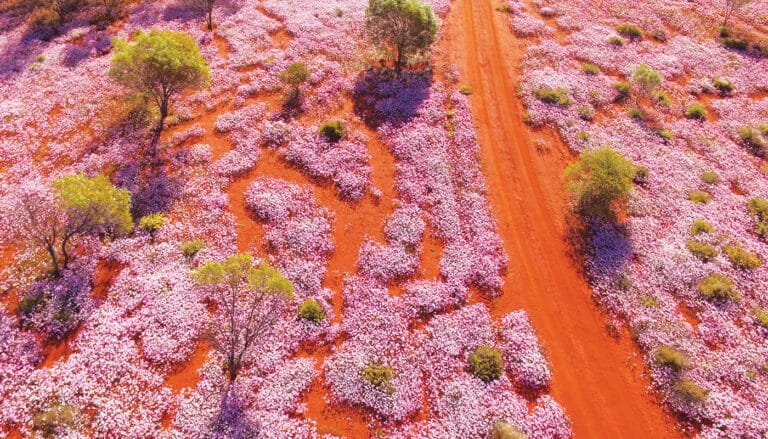6 epic places to camp near wildflowers in Australia




When people think of the Australian landscape, it’s often sparkling beaches, swatches of thick bush or open plains of red dirt that spring to mind. But wildflowers in Australia, while often subtle, are one of the country’s most underrated yet spectacular sights…if you can time it just right.
Here are 6 epic places to camp and see unique wildflowers across Australia:

What you’ll see: Alpine and sub-alpine wildflowers blooming all across the mountains in the summer season in Australia. Walk along the Illawong walk and take a picnic amongst alpine mint, billy buttons, and native yam daisies. Or head up high along the main range walk, where you’ll find open fields blooming with snowy white gentians, anemone buttercups and alpine sunrays.
How to get there: Head 2.5 hrs southwest by car along the Monaro Highway and Kosciusko Road, following signs to Jindabyne and Thredbo.
When to visit: November to April is the best time to catch these wildflowers in Australia that appear after the snow has melted away.
Where to stay: Camp on the river at Thredbo Diggins for picturesque campsite scenery and easy access to walks and scenic drives across the mountains.

What you’ll see: Blankets of yellow and pink everlastings spring up in droves, contrasting magnificently with the red dirt. The 3.2 km plateau walk train is an excellent way to soak up the flowers in all their glory. If that’s not enough wildflowers, take one (or more) of the interpretive self-drive tours through the broader Wildflower Country in Western Australia to experience all the region has to offer.
How to get there: Drive 4.5 hours north from Perth or 1 hour west from Geraldton to reach this wildflower paradise.
When to visit: After the winter rain in late July and through to October is the best time to see wildflowers in bloom here.
Where to stay: Camp smack bang in the middle of the flowery displays at Miners Campground.

What you’ll see: The Flinders Ranges in Australia can be a dry and desolate place, but it changes drastically with the rain into a spectacle of wildflowers. You can expect to see a colourful range of flowers, including Fringe Myrtle, Guinea Flower, Lavender Grevillia and Mintbush. Take one of the many walks into Wilpena Pound to see them up close and personal. Razorback Lookout is the perfect sunset or sunrise spot to watch the vast expanse of wildflowers glow with golden hour light against the backdrop of the walls of the Ranges.
How to get there: Head directly north from Adelaide for 450km, following signs to Hawker and Wilpena Pound and Flinders ranges.
When to visit: Wildflowers here depend on the winter rains, but September to November is usually the best time to visit.
Where to stay: Wilpena Pound is an excellent base camp to explore the surrounding wildflower walks and scenic drives.

What you’ll see: One of the most famous and spectacular Australian Wildflowers is the Sturt’s Desert pea, which grows naturally in outback Australia. It loves the red sandy soils, which are abundant in the red centre but you have to be lucky because they only spring up when conditions are just right. They’ve even been known to bloom all over the town of Alice Springs after the right amount of rain!
How to get there: The Red Centre is the region around the town of Alice Springs. You can fly to Alice Springs from most Australian airports or travel there over a couple of days by car.
When to visit: The late dry season from July – September after some good rain is the best time for desert wildflowers in The Red Centre of Australia.
Where to stay: Great camping spots can be found throughout the region in the West MacDonnell Ranges, Yulara and Finke Gorge National Park.

What you’ll see: The name Giraween actually means place of flowers, so you know it’s going to be one of the most epic displays of wildflowers in Australia. Giraween also features magnificent granite outcrops and formations that contrast brilliantly with bursts of white heath bells, and bold yellow, purple and red pea flowers.
You can also expect to find low-lying grass flowers like billy buttons, native bluebells, native sarsaparilla and native daisies. The show ends in November with spectacular displays of the famous snowy white flannel flower.
How to get there: This lush green park sits right above the QLD/NSW border, a 4-hour drive from both Byron Bay and the Gold Coast.
When to visit: Flowers start to bloom here in late July and peak in Spring through September and October.
Where to stay: There are 10 campgrounds in Giraween National Park to choose from, with options ranging from remote bush camps with no facilities to RV and trailer-friendly spots with plenty of amenities.

What you’ll see: While best known in Australia for its magnificent waterfalls, sweeping rivers and otherworldly rock formations, in the early dry season, these spots are given an extra sparkle with the appearance of wildflowers. Kapok flowers burst from the end of long, spindly branches, highlighting magnificent views. A field of fluffy purple Mulla Mulla covers the ground, contrasting with the bright red dirt and harsh landscape.
How to get there: The Kimberly is a vast and spectacular region that stretches from Broome through to Kununurra on the NT border. You can Fly directly to Broome or drive over a day or two from Darwin or Perth.
When to visit: The dry season from June to August is the best time to spot wildflowers in the North West.
Where to stay: There is a huge array of camping options throughout the Kimberley. Spots that combine great views with gorgeous flora include Purnululu National Park, Lake Argyle, and the Gibb River Road.